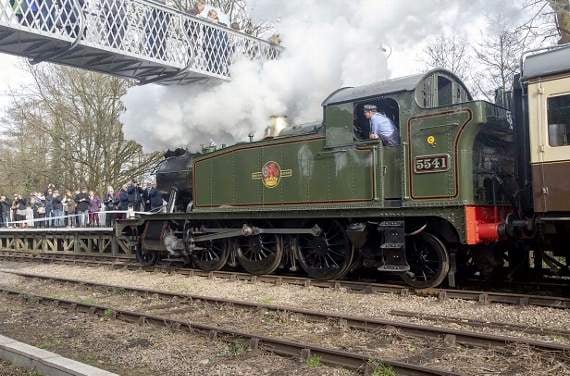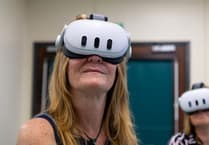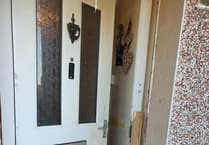IT’S a unique link with the past and has been a much-missed link between two parts of Lydney but on Saturday (March 9), the lovingly-restored St Mary’s footbridge was officially opened.
Fittingly, the ribbon was ‘cut’ by a steam locomotive in front of more than 100 invited guests and members of the public with music by Chepstow Town Band.
The bridge, which was opened to the public in 1892, is a beautiful piece of Victorian engineering and is one of the last pieces of infrastructure of the former Severn and Wye Railway.
It is descibed by Historic England as “a vey complete survival, elegant and of great economy in engineering design.”
It was closed in 2007 because of safety concerns, cutting off a well-used link between Lakeside and the area near the church.
The High Sheriff of Gloucestershire, Charles Martell, who waved the flag to set off the train for the ribbon cutting, said: “We speak of building bridges meaning a bringing back together.
“This bridge, after a closure of 12 or so years will do just that.”
The Dean Forest Railway was determined that the bridge would be restored and re-opened.”
After obtaining grant funding for the work, the Grade II listed structure was carefully dismantled for specialists Mabey Bridge to restore to its original form.
The bridge was originally built in kit form by George Smith and Co of Glasgow.
The cost was £247 – around £24,600 at today’s prices – although extra work added another £20.
Even when the bridge was in the secure workshop, each of the individual pieces remained listed.
The list of works included replacement of the lower deck chords, 11 new cast iron stair risers, new deck plates, new finials for the lanterns and 470 rivets.
It returned ‘home’ in January this year, transported by the railway’s fleet of heritage wagons.
It was re-erected using the railway’s 15-ton diesel crane which had been restored by volunteers.
General manager of the railway, Duncan Rowe, said: “We are here to celebrate the re-opening of this magnificent Grade II-listed bridge which was put back in place to do what it was original built for in 1892.
“The bridge is an amazing asset not only to the railway but to the local community to enjoy, use and cherish.
“The restoration of the bridge has been made possible by the huge amount of effort by dedicated people who were involved in this project.
“People supported us all the way through by fund-raising, planning, dismantling, the restoration and the re-installation and I would like to give heart-felt thanks to everybody who was involved.
“I would also like to make a special thank you to Mabey Bridge, our principal contractor, for their on-going support, guidance
and knowledge.
“A special thank you has to go to our loyal, enthusiastic volunteers because without them St Mary’s bridge would not be in the fantastic state it is in now and without them we would not have the railway.
“The railway brings in tens of thousands of visitors to the area and supports many local businesses.
“Our volunteers are the heart and soul of this railway and without their steadfast commitment, hard work and passion we would not be here today to celebrate the opening of St Mary’s Bridge.”
The celebrations began with a special train taking guests from the railway’s headquarters at Norchard.
Mr Martell said they were “looking at the construction of not just architectural merit but an item of magnificent functionality which will go on serving the people of this area.”
But, he said, the most important part of the venture was the people involved.
He unveiled a plaque in honour of the late Mr Melville Watts and his great nephew Mr Adam Thurston who had facilitated the restoration.
He added: “To the unknown artisans, be it smelters, casters or rivetters who fabricated, assembled and erected this bridge and the thousands of people crossings this bridge has facilitated in its life from 1892 to its enforced closure in 2007.
“Thanks to the capability and enthusisam of the Dean Forest Railway volunteers, the money raisers and donors and the modern day artisans at Mabey who maintain the skills to restore this structure.
“This bridge was ordered and erected in the space of a year or so.
That is testament to the engineering sophistication of the period, the bridge having been assembled from standard parts.
The original Severn and Wye Railway, although financially constrained in 1891, decided it was too dangerous to continue to allow people to dodge trains as they crossed the line.”
According to the company’s minutes of August 1891, people were walking over the line between the tinplate sidings and the church because coal trains standing opposite the church prevented them from using the public footpath through the churchyard and crossing the railway.
The solution was the elegant cast iron bridge that has now been given a new lease of life.





Comments
This article has no comments yet. Be the first to leave a comment.